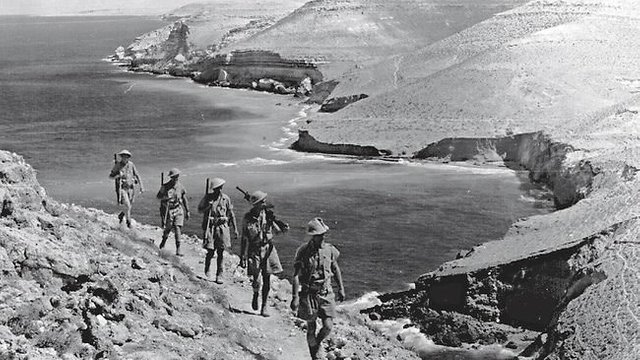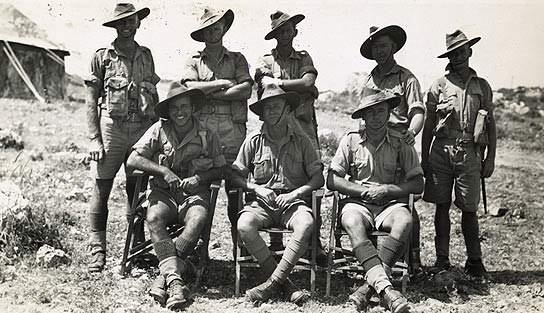Tobruk part one: An introduction - Rats in a trap? Not on your bloody life mate!
When someone is called a rat these days the connotation is generally negative; Rats are dirty things that skulk around in dark places, feeding on what they can, garbage and waste, and largely out of mind until seen. They scavenge and dig, living the best they can. However there were a group of men who were proud to call themselves rats a little while back. Let me tell you about them.

The year was 1941 and 14,000 Australian soldiers were besieged in the Lybian port of Tobruk by a combined German-Italian force commanded by none other than General Irwin Rommel; The Desert Fox. The Afrika Corps were well known for their tactics, brutality and held the advantage through overwhelming numbers and excellent equipment and training. Facing General Rommel was Lieutenant General Leslie Morshead and his Tobruk Garrison comprised the 9th Division (20th, 24th and 26th Brigades) the 18th brigade of the 7th Division and four regiments of British artillery and a handful of Indian troops also.
The port of Tobruk was vital to the defence of the Suez Canal and Egypt as control of the harbour would force the enemy to bring supplies overland from Tripoli, a journey of some 1,500 kilometres of harsh desert and would also divert troops from their advance on Egypt and Suez. Defended by an outgunned and undersupplied force the garrison was bombed and shelled relentlessly, the German Stuka dive-bomber's sending precisely-aimed ordinance into every nook and cranny leaving the defenders no place to hide. Ground assaults were also common and Rommel sent his brutally efficient 21st and 15th Panzer divisions rolling hot towards Tobruk supported by thousands of troops to break the garrison; But break they did not. There was no glory in each successful defence against the enemy though for supplies were short and casualties high. Life was harsh, hot and often short-lived in Tobruk. Attack after attack wore the men down and life became almost intolerable. And so they dug in. Like rats.

The term rats was first referred to in respect of the defenders by the Nazi propagandist Lord Haw Haw the Irish-American, William Joyce, whose pro-Nazi radio broadcasts were supposed to demoralise the allies. The name rats was used as a derogatory term of course. It stemmed from the fact that the largely Australian garrison would counter-attack the moment the enemy was routed to gather supplies and scavenge off the battlefield for weapons, ammunition, food water, boots and anything that could aid in the defence of the port and the continuance of their lives. They had also dug an extensive tunnel network to support their trenchworks linking them together to make communications more effective and travel safer during Stuka raids and artillery bombardment. Radio Berlin's Lord Haw Haw said the garrison of Tobruk were, "caught like rats in a trap".
Of course, Australian's being Australian's, they twisted the insult to their own gain and henceforth dubbed themselves, THE RATS OF TOBRUK wearing the name with pride and honour - To this very day I might add.
Supplies trickled through the the defenders of Tobruk via the Royal Navy and the Royal Australian Navy however it was a dangerous task due to bombing and those bloody Stuka's! A couple of destroyers were sunk along with three sloops and some 20 or so other vessels and a sunk ship in the harbour made access difficult. It was a balancing act to get the supplies in and not get bombed at the same time which is why supplies were so sporadically delivered.
The siege continued between April and the end of November of 1941. In August half the Australian garrison was relieved however one Batallion, the 2/13 Battalion could not be relieved and were the only unit to see out the entire siege. casualties were as follows:
- Australian casualties (9th Division) from April to October numbered 749 killed, 1,996 wounded and 604 prisoners.
- Total losses (9th Division) and attached troops from 1st March to 15th December amounted to 832 killed, 2,177 wounded and 941 prisoners.

The siege was a critical part of the African war during World War Two but was only that, a part. This chapter of the war is just like the others; Filled with heroism, cowardice, suffering, humour, sacrifice, great humanity and the worst of what humans can do to each other also. The war in Africa was fought in baking hot and bitingly cold desert temperatures. It saw Allied armour pitted against the might of Rommel's Panzer's (like pitting a corgi dog against a German Shepard really), sweeping tank battles, infantry pitched in hand to hand, muzzle to muzzle warfare, booming artillery exchanges with Rommel's artillery and lethal 88's and stealthy SAS commando missions behind enemy lines. I plan to tell more of those stories over time.
Thanks for reading and if you are interested keep a look out for the next post about the Rat's of Tobruk and the desert war of World War Two. I plan to tell a few stories from both sides of the conflict as well, not just the Aussies.
[- Design and create your ideal life, don’t live it by default - @galenkp -]
Rats on patrol image source
The Rats image source
German Panzer Source
This is a really good article. The first time I can remember hearing about the Desert Rats was as a kid on a television series called the “Rat Patrol.” Running circles around the Germans in lightly armed Jeeps made for exciting TV but it must have been pure hell for the men who had to actually do it. They were tough bastards for sure.
Thanks mate, I’m proud of the Aussie blokes but there were British and Indians there too! The British commando’s did some pretty daring stuff as well. Of course on the other side (Axis powers) there were some outstanding soldiers who went through similar hardships and suffering also. War is hell, they say. I did part two tonight and will do part three mid-week I think. I reckon I’m going to flip it and give a different perspective rather than from the Australian’s point of view. We’ll see. The Rat Patrol was so cool! I recall the show too. Loved it as a kid.
Thanks for commenting favorably mate. I hope you have a great Sunday. Mine is just about over. It’ll be weekend + one soon (Monday) and the rat race starts.
I didn't know that. It's a fascinating aspect of the war that apparently is covered much. I like your writing style as well. Very professional, flows easily.
Thank you for your kind words. I tend to just write how I think mostly so am glad it comes across well. I’m not a writer and not an overly educated person having not actually finished high school but I’m passionate about what I do and I suppose that may come across at times. I’m planning to write more about the desert war so hopefully you find them interesting also if you come across them.
You don't come across like you didn't finish high school. I can see you have a passion for history. It's important to remember the past so we hopefully don't make the same mistakes. It doesn't seem like that's going to be the case, but at least some people haven't forgotten.
I have spent my life trying to better myself, learn, grow and develop as a person and despite not finishing school have a reasonably solid command of many concepts including the English language. I’m no intellectual of course however can converse well with most people, write reasonably well and have valid and informed opinions. I’m also wise enough to know when to listen and when not to. I tend to be a bit of a sponge soaking up knowledge where I can.
On history, I guess I tend to look back because my impression of the future is bleak.
Well researched, well written and fascinating post. Great work.
Thank you for reading and responding. I’m passionate about history and Australian war history so it’s easy to do my research.
My absolute pleasure. It is a topic that interests me too. One of the most memorable travel experiences I had was walking in our soldiers footsteps at Normandy.
Normandy is on my list. I've done the Kokoda Trail (2007) and done six days on the Western Front (France/Belgium)...Both Kokoda and the Western Front are incredibly moving and emotional experiences. I've done blogs about both, way back on my feed. We're heading to the UK for six weeks in June/July this year so looking forward to checking out some history there as well. Not as much Aussie war history there but I've traced my ancestry back to 1451 in Paul, Cornwall so that should be a buzz. I might be heir to a castle. :)
Check out my 3 Kokoda blogs and Western Front blogs from ages ago if you like and here's one a did a while back on the Light Horse: https://steemit.com/history/@galenkp/from-colonial-cavalry-to-the-australian-light-horse
Kokoda scares me. I'd love to do it though. I find they are all so emotionally charged. I think of all the young men I know and see them scaling cliffs or beating through the bush. It breaks my heart. I'll definitely check out those other articles.
I took on the Kokoda Trail as a personal challenge and to honour the men (average are 19) who fought, suffered and died, on the Trail in world war two. It's an emotional trek and an exercise in mental toughness. Most of the trekking is done solitary, alone but one's thoughts. The trekkers come together at the lunch break or end of day and exchange thoughts, talk about the world, life and what they discovered about themselves that day. It changed my life. I recommend every Australian does it, those who are capable. It gives the trekker a small glimpse of the level of mental and emotional commitment the troops had to display.
Thanks for reading and commenting. I appreciate it, as always.
Despite the wars being fought today I really don’t think we will ever understand the loss of life during World War 2 or the conditions they faced.
I think it’s difficult to understand for people that haven’t been there.